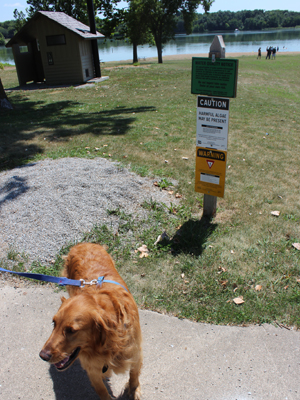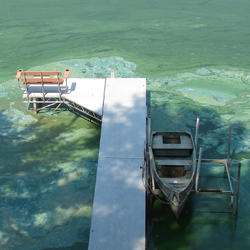First Toxic Algae Blooms of the Summer
posted
on Friday, July 1, 2016
 |
| Pets are very vulnerable to algae poisoning. If algae warnings are present, do not let pets come into contact with the water. |
Summer is in full swing and many Iowans are heading to their local state park beaches to swim and go boating. However, last week two of Iowa’s state park beaches received this summer’s first round of swimming advisories for high levels of microcystin, a toxin produced by some forms of blue-green algae, and three new warnings were posted yesterday, bringing this summer's total thus far to five warnings.
The Iowa Department of Natural Resources (DNR) posted warnings at Green Valley State Park and Union Grove State Park last week and Green Valley Lake, Lake of Three Fires and Viking Lake this week cautioning Iowans to stay out of the water due to microcystin levels higher than 20 micrograms/liter – the threshold established by the World Health Organization for recreational waters. Green Valley State Park, Union Grove State Park and Lake of Three Fires State Park have been plagued with high microcystin levels the past few years. In 2015 alone, Green Valley Lake Beach had warning signs for blue-green algae posted for nine of the 16 weeks of summer.
In 2015, Iowa experienced record breaking beach advisory warnings due to toxic microcystin levels – 34 warnings compared to 24 in 2013 – and DNR predicts 2016 will be another record-breaking summer.
With the 4th of July right around the corner - one of Iowa's busiest beach weekends – it is especially crucial that Iowans are aware of the dangers microcystin poses to both people and pets.
“The threats posed by toxic blue-green algae blooms are serious,” said Water Program Director Susan Heathcote. “Iowans need to be aware of this problem, the health risks, and know how to recognize and respond if they think they’ve been exposed.”
 |
| Toxic blue-green algae blooms vary in color from a bright blue to a vibrant green and often resemble spilled paint. |
Microcystin is caused by phosphorus water pollution combined with hot temperatures. At Iowa’s beaches, microcystin takes the form of toxic blue-green algae. Toxic blue-green algae blooms vary in color from a bright blue to a vibrant green. These blooms create a murky water with visible surface scum resembling spilled paint, and have a foul odor. These blooms tend to accumulate in shoreline areas, but can spread across the water.
Exposure to microcystin levels at or greater than 20 ug/l can cause a variety of health issues including breathing problems, upset stomach, skin reactions, and even liver damage. Inhaling water droplets containing microcystin from toxic blue-green algae can cause a runny nose, irritated eyes, coughs, sore throats, chest pain, asthma-like symptoms or allergic reactions. The Iowa Department of Public Health permanently added “microcystin-toxin poisoning” to the list of diseases health providers must report in 2015.
Microcystin also poses a very serious threat to animals. Pets and other animals that swim or drink the water can be exposed to deadly levels of microcystin. If there are advisory warnings do not let pets drink or get into the water, even if the temperature is very hot outside. Animals are at just as great of risk—or more—of microcystin poisoning as people.
If you think you or your pets may have been exposed to toxic blue-green algae, thoroughly wash it off with fresh water. If you or your pet experience symptoms associated with high microcystin levels, seek medical or veterinary care immediately.
In addition to 2015’s record-breaking number of warnings, six new lakes were issued advisory warnings due to high microcystin levels. Since 2006, when weekly monitoring for microcystin began, there have been a total of 150 beach advisory warnings due to microcystin.
“To rid Iowa of toxic blue-green algae blooms and ensure our lakes are safe and healthy for our families and pets, we must improve our water quality and reduce phosphorus pollution caused by agricultural and urban runoff and wastewater treatment systems,” said Agricultural Policy Specialist Ann Robinson.
The Iowa DNR monitors 39 State Park beaches for microcystin on a weekly basis from Memorial Day to Labor Day, issues advisories and posts warning signs on the beaches when conditions become unsafe for swimming. The weekly beach advisories can be found on their website, where you can also find beach advisory warnings for bacteria pollution, specifically e. coli, another health threat that can be potentially serious. This past week alone there were six beach advisory warnings posted due to high bacteria levels.
At this time, the DNR only monitors state park beaches, so if you are swimming at other public or private beaches it is important to be aware of potential toxic blue-green algae blooms and high bacteria levels throughout the summer. Not all blue-green algae in the water is toxic; green algae that appears stringy and floats in large clumps is not dangerous. When in doubt stay out of the water and call the DNR Beach Monitoring Hotline at 515-725-3434.
- phosphorus pollution
- toxic algae
- water quality